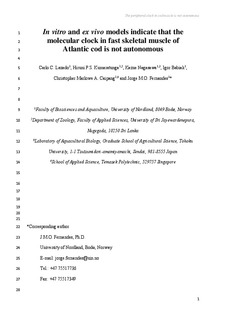| dc.contributor.author | Lazado, Carlo Cabacang | |
| dc.contributor.author | Kumaratunga, Palawinnage Hiruni Senari | |
| dc.contributor.author | Nagasawa, Kazue | |
| dc.contributor.author | Babiak, Igor | |
| dc.contributor.author | Caipang, Christopher Marlowe A. | |
| dc.contributor.author | Fernandes, Jorge M.O. | |
| dc.date.accessioned | 2015-03-14T08:43:48Z | |
| dc.date.accessioned | 2015-03-16T13:01:30Z | |
| dc.date.available | 2015-03-14T08:43:48Z | |
| dc.date.available | 2015-03-16T13:01:30Z | |
| dc.date.issued | 2014 | |
| dc.identifier.citation | Lazado, C.C., Kumaratunga, P.H.S., Nagasawa, K., Babiak, I., Caipang, C. and Fernandes, J.M.O. (2014). In vitro and ex vivo models indicate that the molecular clock in fast skeletal muscle of Atlantic cod is not autonomous. Molecular Biology Reports, 41(10), 6679-6689. doi: | nb_NO |
| dc.identifier.issn | 1573-4978 | |
| dc.identifier.uri | http://hdl.handle.net/11250/279355 | |
| dc.description | Author's accepted version (post-print). | nb_NO |
| dc.description | The final publication is available at Springer via http://dx.doi.org/10.1007/s11033-014-3551-5. | |
| dc.description.abstract | The hypothesis that the circadian rhythm is exclusively regulated by a central clock has been challenged by the discovery of peripheral oscillators. These peripheral clocks are known to have a direct influence on the biological processes in a tissue or cell. In fish, several peripheral clocks respond directly to light, thus raising the hypothesis of autonomous regulation. Several clock genes are expressed with daily rhythmicity in Atlantic cod (Gadus morhua) fast skeletal muscle. In the present study, myosatellite cell culture and short-term cultured fast skeletal muscle explant models were developed and characterized, in order to investigate the autonomy of the clock system in skeletal muscle of Atlantic cod. Myosatellite cells proliferated and differentiated in vitro as shown by the changes in cellular and myogenic gene markers. The high expression of myogenic differentiation 1 (myod1) during the early days post-isolation implied the commitment to myogenic lineage and the increasing mRNA levels of proliferating cell nuclear antigen (pcna) indicated the proliferation of the cells in vitro. Transcript levels of myogenic marker genes such as pcna and myogenin (myog) increased during five days in culture of skeletal muscle explants, indicating that the muscle cells were proliferating and differentiating under ex vivo conditions. Transcript levels of the clock gene aryl hydrocarbon receptor nuclear translocator-like 2 (arntl2) in myosatellite cells showed no daily oscillation regardless of photoperiod manipulation. On the other hand, mRNA levels of the clock gene circadian locomotor output cycles kaput (clock) showed circadian rhythmicity in 5-day-old skeletal muscle explant under different photoperiod regimes. Expression of arntl2, cryptochrome2 (cry2), period 2a (per2a) and nuclear receptor subfamily 1, group D, member 1 (nr1d1) was not rhythmic in muscle explants but photoperiod manipulation had a significant effect on mRNA levels of cry2 and per2a. Taken together, the lack of rhythmicity of molecular clocks in vitro and ex vivo indicates that the putative peripheral clock in Atlantic cod fast skeletal muscle is not likely to be autonomous. | nb_NO |
| dc.language.iso | eng | nb_NO |
| dc.publisher | Springer | nb_NO |
| dc.title | In vitro and ex vivo models indicate that the molecular clock in fast skeletal muscle of Atlantic cod is not autonomous | nb_NO |
| dc.type | Journal article | nb_NO |
| dc.type | Peer reviewed | nb_NO |
| dc.date.updated | 2015-03-14T08:43:48Z | |
| dc.subject.nsi | VDP::Agriculture and fishery disciplines: 900::Fisheries science: 920::Fish health: 923 | nb_NO |
| dc.source.pagenumber | 6679-6689 | nb_NO |
| dc.source.volume | 41 | nb_NO |
| dc.source.journal | Molecular Biology Reports | nb_NO |
| dc.source.issue | 10 | nb_NO |
| dc.identifier.doi | 10.1007/s11033-014-3551-5 | |
| dc.identifier.cristin | 1141250 | |
| dc.relation.project | Norges forskningsråd: 190350 | nb_NO |
